Before I ever thought about removing sugar from dessert, I was convinced a cheesecake without it would taste… well, like sadness on a plate. That changed one rainy afternoon when I decided to tinker with my grandma’s famous cheesecake recipe. I swapped the sugar for monk fruit sweetener, kept the same creamy filling, and braced myself.
The result? A sugar-free cheesecake so velvety and indulgent that my family polished off the whole thing without realizing it was “healthy.” This article will guide you through the best ingredients, the creamiest method, and even a few fun twists so your sugar-free cheesecake tastes like it came from a bakery—not a health food aisle.
My First Sugar-Free Cheesecake Success
Turning tradition into sugar-free bliss
My baking style has always been rooted in tradition, so reinventing a classic like cheesecake felt risky. But as I started exploring diabetic-friendly desserts, I realized sugar-free cheesecake could be just as decadent as the original. The key was choosing a natural sweetener that didn’t leave a bitter aftertaste. Monk fruit and allulose became my go-to combo, giving me the smooth sweetness of sugar without the blood sugar spike. The crust, made with almond flour and a touch of butter, stayed crisp yet tender—just like the ones I grew up eating.
I also discovered that sugar-free cheesecake isn’t just for people with dietary restrictions. Friends who usually avoid “healthy desserts” admitted they preferred this version because it felt lighter, less cloying, and more flavorful. That’s the magic of finding balance—keeping the indulgence while removing what doesn’t serve you.
Why sugar-free doesn’t mean joy-free
There’s a misconception that sugar-free equals bland. But when you use real vanilla extract, quality cream cheese, and a gentle sweetener, every bite still delivers that familiar richness. In fact, without the overpowering sweetness of refined sugar, the tang of cream cheese and the depth of the crust shine through more. And let’s be honest—cheesecake is about texture just as much as taste. Slow baking at a low temperature keeps the filling ultra-smooth, so you get that satisfying fork glide every single time.
If you’re curious to try, you can also explore my healthy dessert recipes and diabetic-friendly cakes for more inspiration. Both are packed with flavor and free of unnecessary sugar, proving dessert can be both indulgent and mindful.
Choosing the Best Ingredients for a Perfect Sugar-Free Cheesecake
Finding your ideal sugar substitute
The sweetener you choose can make or break a sugar-free cheesecake. It’s not just about sweetness—it’s about texture, aftertaste, and how well it holds up during baking. Here’s a quick guide to help you decide:
| Sweetener | Pros | Cons |
|---|---|---|
| Monk Fruit | Natural, clean taste, no aftertaste | Can be pricey |
| Erythritol | Low cost, widely available, no blood sugar spike | Slight cooling effect on tongue |
| Allulose | Very similar to sugar in taste and browning | Slightly less sweet, may need more |
| Stevia | Highly concentrated, natural | Bitter aftertaste if overused |
For most bakers, a blend of two sweeteners works best. My favorite mix is monk fruit with allulose—it gives a balanced sweetness without the cooling sensation erythritol sometimes brings.
Choosing the right dairy base
Cheesecake’s star ingredient is, of course, cream cheese. But the type you choose changes everything. Full-fat cream cheese delivers the richest texture, while low-fat or Neufchâtel makes the dessert lighter but slightly less creamy. If you’re dairy-sensitive, you can try lactose-free cream cheese or even a cultured cashew cream for a plant-based twist. Greek yogurt is another excellent addition—it lightens the texture and adds a subtle tang.
And don’t forget the eggs: room-temperature eggs blend more smoothly and help create that custard-like consistency. For a sturdier cheesecake, add one extra egg; for a softer, creamier bite, stick to the classic ratio.
If you need ideas beyond cheesecake, check out my low-carb dessert recipes and cream cheese dessert recipes. They’ll help you see how versatile these ingredients can be.
Also Read: Frankenstein Oreo Balls – A Spooky & Delicious Halloween Treat
Step-by-Step Method for the Creamiest Sugar-Free Cheesecake
Building the perfect crust
A good cheesecake starts from the bottom up. For a sugar-free cheesecake, almond flour is my crust hero—it’s naturally low in carbs and has a nutty depth that pairs beautifully with the creamy filling. To make it, mix almond flour with melted butter, a touch of cinnamon, and your chosen sweetener. Press it firmly into the bottom of a springform pan and bake for about 8–10 minutes at 350°F until lightly golden. This quick pre-bake keeps the crust crisp instead of soggy once the filling is added.
If almond flour isn’t your thing, crushed sugar-free cookies or coconut flour are great alternatives. Just remember to add enough butter so the crust holds together without crumbling.
Baking vs. no-bake cheesecake
Baked sugar-free cheesecake is the classic choice—dense, smooth, and slightly tangy. The trick is a low-and-slow bake in a water bath (also known as a bain-marie). This gentle heat prevents cracks and ensures the filling cooks evenly. Bake at 300°F until the edges are set but the center still has a slight jiggle.
If you’re after a lighter texture or want to avoid turning on the oven, go no-bake. Simply whip cream cheese with sweetener, vanilla, and heavy cream until fluffy, then chill for several hours until firm. The no-bake method is quicker, but it won’t have that same deep flavor you get from baking.
For more inspiration, you can browse my no-bake cheesecake recipes and keto dessert recipes, where I share variations that are just as luscious as traditional versions.
Flavor Variations & Serving Ideas
Elevating your cheesecake with toppings and mix-ins
A plain sugar-free cheesecake is a beauty on its own, but adding the right toppings can turn it into a showstopper. For a fruity note, simmer fresh or frozen berries with a splash of lemon juice and your favorite sweetener to make a vibrant sugar-free compote. Swirl it into the batter before baking for a marbled effect or spoon it on top just before serving. Chopped toasted pecans or almonds add crunch, while a light drizzle of melted sugar-free dark chocolate creates a decadent touch without spiking your carbs.
For more adventurous bakers, try folding sugar-free peanut butter into the batter for a nutty twist, or add a hint of espresso powder for a mocha-inspired cheesecake. These small changes make it easy to customize your cheesecake for any occasion.
Presentation & storage tips
Cheesecake loves a little chill time—it’s actually better the next day once the flavors have melded. After baking, let it cool completely before refrigerating for at least 4 hours, preferably overnight. For a clean slice, dip your knife in hot water and wipe it between cuts.
If you’re serving at a gathering, consider pre-slicing and adding individual garnishes like mint leaves, mini berries, or a light dusting of cocoa powder. Store leftovers in an airtight container in the fridge for up to 5 days, or freeze individual slices for quick dessert fixes.
For more decorative ideas, explore my fruit dessert recipes and holiday dessert recipes to find plating inspiration that makes your cheesecake as stunning as it is delicious.
FAQs About Sugar-Free Cheesecake
Can you make cheesecake without sugar?
Absolutely. By replacing refined sugar with natural or low-carb sweeteners like monk fruit, erythritol, or allulose, you can create a cheesecake that’s every bit as creamy and indulgent as the traditional version.
Can diabetics eat sugar-free cheesecake?
Yes, when made with low-glycemic sweeteners and a nut-based or low-carb crust, sugar-free cheesecake can be a suitable dessert option for many diabetics. Always check with a healthcare provider for personal dietary advice.
Can I make a cheesecake without icing sugar?
Definitely. Icing sugar is often used in no-bake cheesecakes for smoothness, but granulated sugar substitutes work perfectly in baked versions and many no-bake recipes.
Is cream cheese sugar free?
Most cream cheese is naturally sugar-free, but it’s wise to check labels for added fillers or flavorings that may contain sugar.
Is sugar-free cake ok for diabetics?
Generally, yes. As with sugar-free cheesecake, using low-glycemic sweeteners and nutrient-dense flours makes these desserts more suitable for people with diabetes.
Conclusion
Sugar-free cheesecake proves that you don’t have to sacrifice indulgence for health. With the right sweetener blend, quality cream cheese, and a well-baked crust, you can enjoy every creamy, tangy bite without the sugar rush. Whether you stick to the classic or explore creative variations, this dessert will quickly become a go-to—perfect for family gatherings, special occasions, or even a quiet night in. So grab your mixing bowl and preheat the oven—it’s time to make a sugar-free cheesecake that tastes like a hug in every bite.
If you enjoyed this recipe, you can find more ideas and updates by following Taste to Rate on Facebook or checking out my inspiration boards on Pinterest.
PrintSugar-Free Cheesecake That Feels Like a Hug in Every Bite
- Total Time: 1 hr 25 mins
- Yield: 12 slices 1x
Description
A creamy, indulgent sugar-free cheesecake made with almond flour crust and natural sweeteners. Perfect for low-carb and diabetic-friendly diets.
Ingredients
2 cups almond flour
1/3 cup monk fruit sweetener
1/2 cup unsalted butter, melted
24 oz cream cheese, softened
1 cup allulose or erythritol
3 large eggs, room temperature
1 tsp vanilla extract
1/2 cup Greek yogurt
Pinch of salt
Instructions
1. Preheat oven to 350°F. Line a springform pan base with parchment.
2. Mix almond flour, monk fruit, and melted butter; press into pan. Bake 8–10 minutes.
3. Beat cream cheese and sweetener until smooth. Add eggs one at a time.
4. Mix in vanilla, Greek yogurt, and salt.
5. Pour filling over crust. Bake at 300°F in water bath for 55–65 minutes.
6. Cool completely; refrigerate 4+ hours before serving.
Notes
Use a blend of sweeteners for best taste.
Store in fridge for up to 5 days or freeze slices for up to 2 months.
- Prep Time: 15 mins
- Cook Time: 1 hr 10 mins
- Category: Dessert
- Method: Baked
- Cuisine: American
Nutrition
- Serving Size: 1 slice
- Calories: 320
- Sugar: 1g
- Sodium: 210mg
- Fat: 29g
- Saturated Fat: 17g
- Unsaturated Fat: 10g
- Trans Fat: 0g
- Carbohydrates: 7g
- Fiber: 2g
- Protein: 8g
- Cholesterol: 110mg

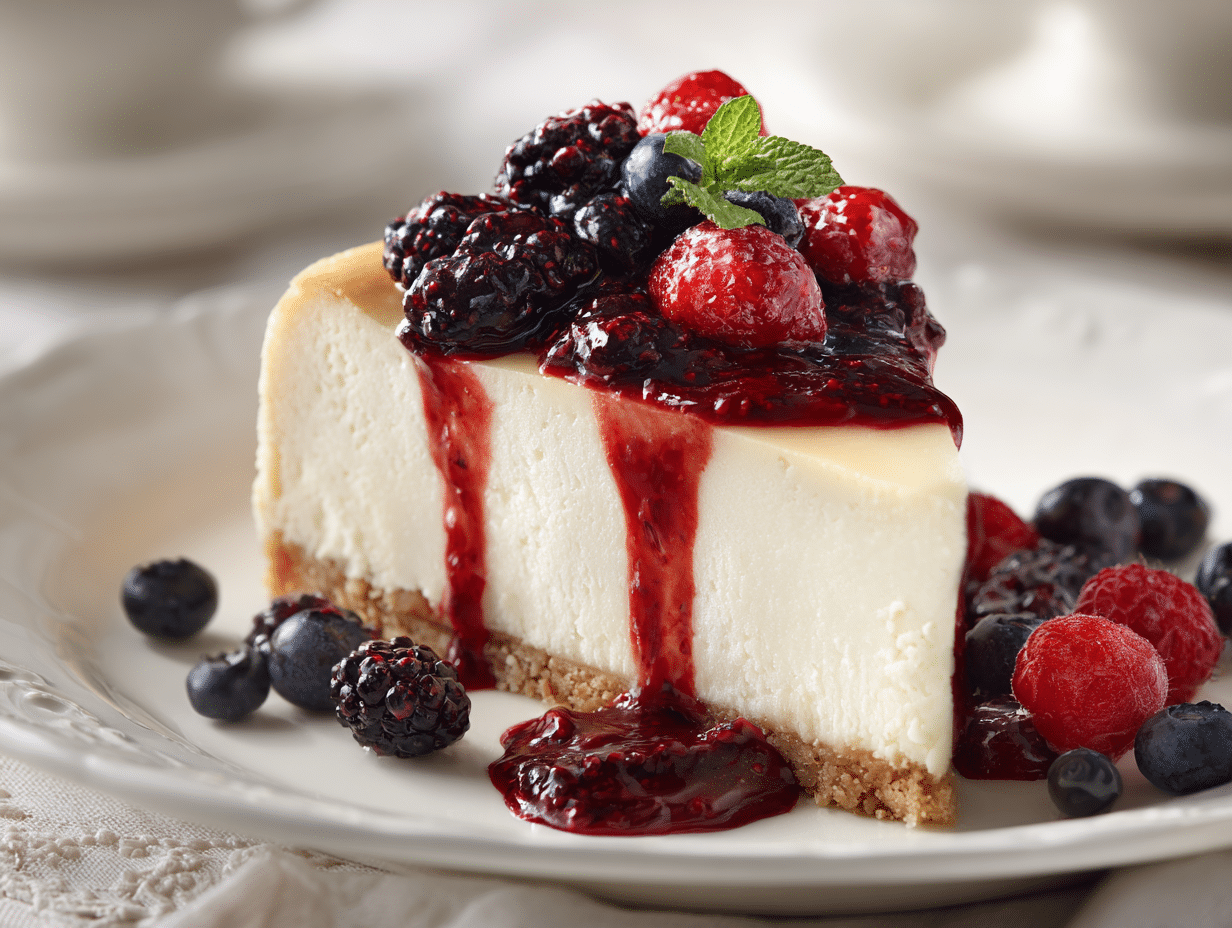
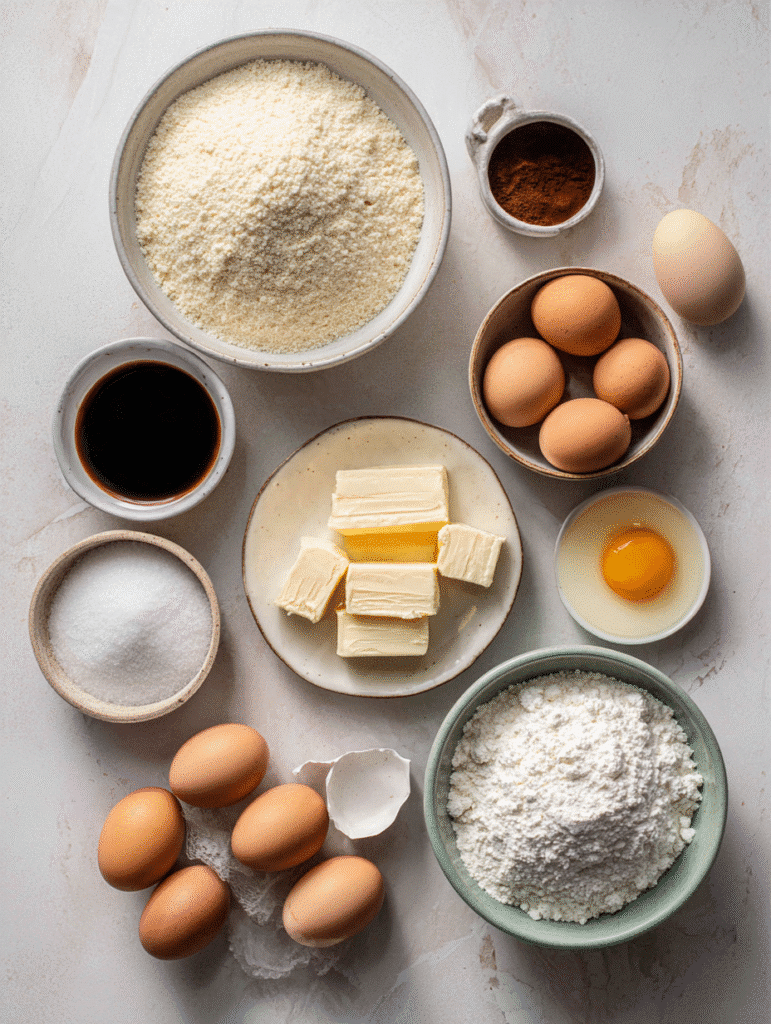
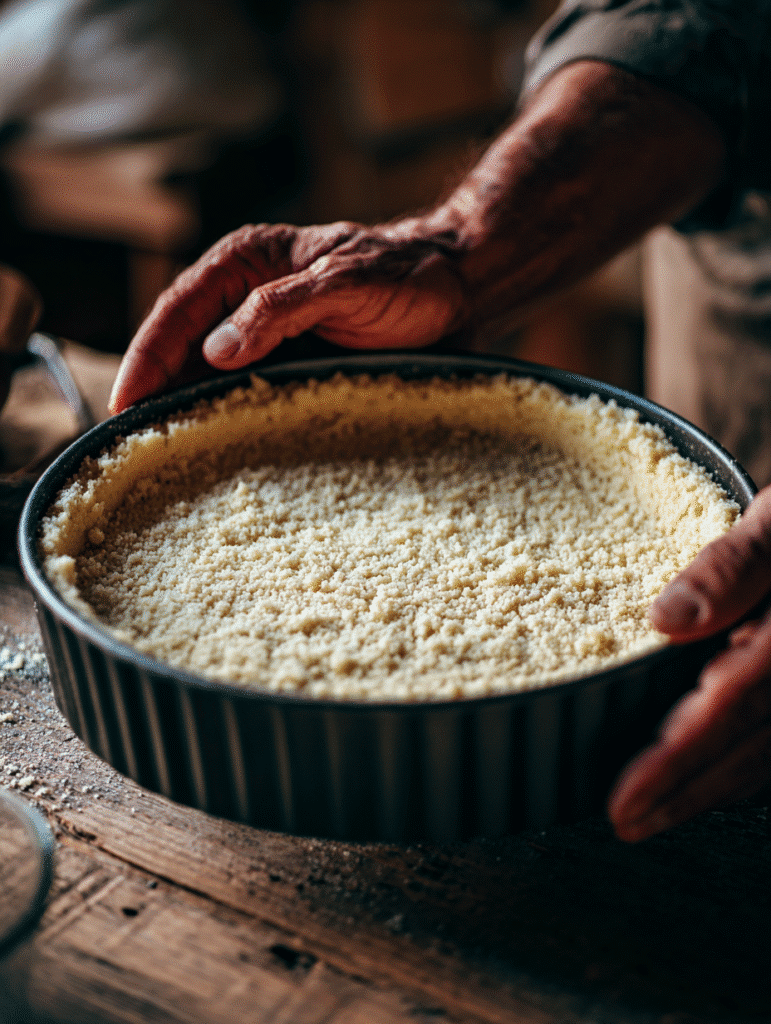
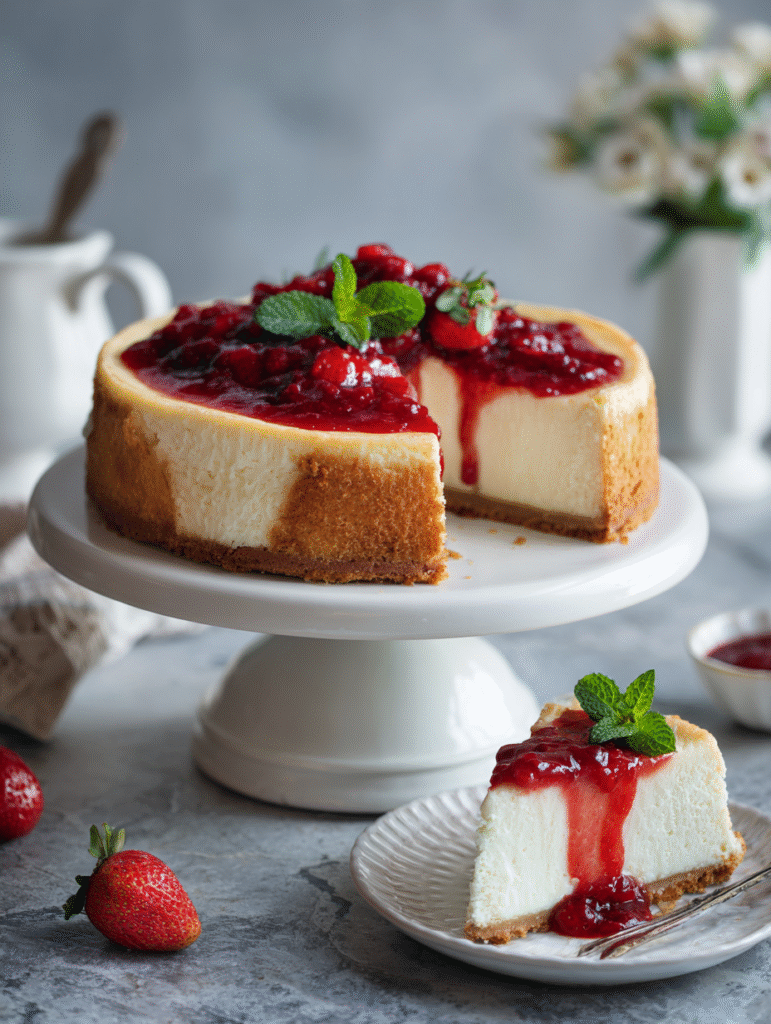
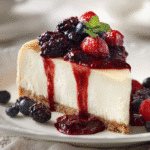
Hi! Super excited to try this recipe. What size spring pan?